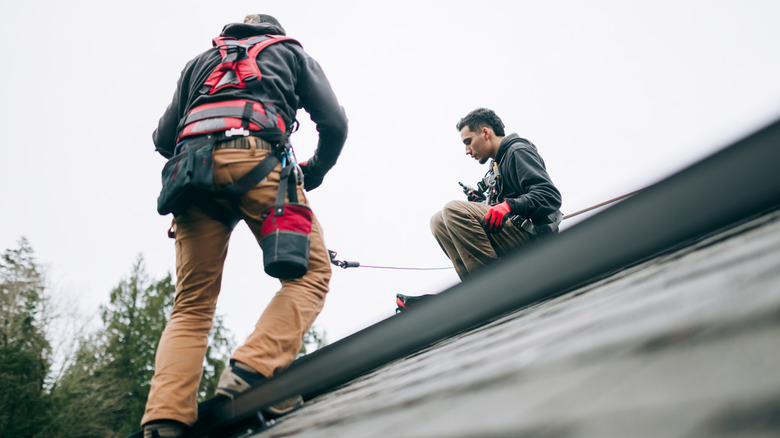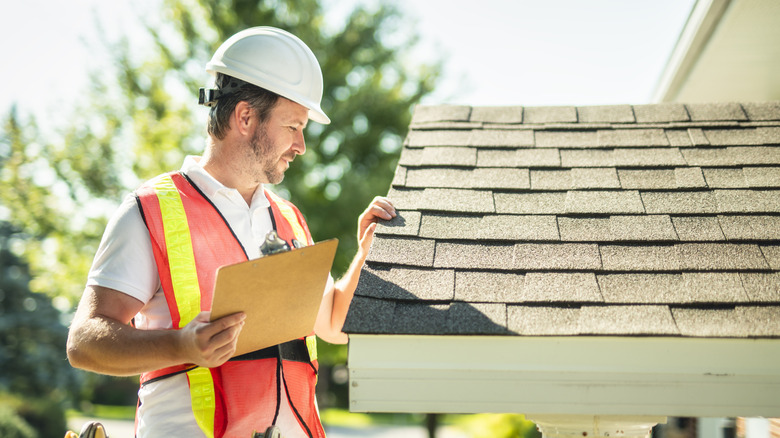The Latest City To Pass A Roofing Law To Combat Rising Temperatures
The city of Atlanta has just joined the growing list of regions rethinking their environmental impact. Earlier this year, officials passed a new ordinance requiring certain new and renovated buildings to use what's known as "cool" roofing — a move aimed at cutting down on how much heat the city absorbs and redirects at night. It's part of a broader push across the South to try and rethink urban heat, especially as extreme weather becomes more common. While the concept may seem like another boring piece of building code, it's one that could quietly reshape the look and feel of the city skyline over time. And unlike many sustainable practices that remain invisible to the average resident, this one will literally be shining in plain sight, right above your head.
So what exactly is a cool roof? The short answer: a roofing system designed to reflect more sunlight than it absorbs, especially when compared to traditional materials. That could mean different types of roofing ranging from light-colored coatings, reflective shingles, or high-tech membranes that cool themselves even in direct sunlight. While the materials may vary depending on the building, the idea remains the same: prevent buildings from turning into giant heat traps. Roofs are often seen as the last layer of protection from the elements, but in this case, they are also part of a broader climate strategy to lower overall city temperatures and energy consumption. You might already recognize a few of them without even realizing — those bright, blinding rooftops that are often scattered around industrial parks and newer apartment complexes. But for Atlanta, this ordinance is about making cool roofs the new norm rather than an exception.
Why are major cities starting to require cool roofing?
Cities like Los Angeles, Chicago, New York, and now Atlanta aren't just turning to cool roofing on a whim — it's backed by tangible environmental science. Urban areas are currently facing record-breaking temperatures, and one of the biggest culprits is known as the urban heat island effect. The materials used to build these cities, mainly concrete, asphalt, and dark rooftops, absorb heat during the day and slowly release it overnight. That constant heat cycle raises temperatures citywide by several degrees, straining energy systems, worsening air quality, and making neighborhoods less livable. By mandating cool roofs, cities are effectively trying to mitigate that cycle, one building at a time. The concept might seem simple, but the implications are tangible — lower rooftop temperatures can mean cooler interiors, reduced air conditioner usage, and noticeable drops in ambient heat outdoors.
The ordinance also brings environmental benefits to the city. Every degree of cooling means less energy is necessary in order to keep spaces comfortable, directly translating to lower emissions from power generation. Studies have shown that cool roofs can lower energy consumption by anywhere from 10% to 15%, even reaching a resounding 20% in warmer climates. And, while every city can't retrofit its entire skyline overnight, a heat-resistant roof style that can lower energy costs is a step in the right direction. For the city of Atlanta, the switch to brighter rooftops could mean a cooler, greener tomorrow. But what implications do these policies have for the average homeowner?
How it might impact you
The new ordinance doesn't require homeowners to repair or replace their roofing immediately. Instead, it specifically targets newer construction or when existing roofs are undergoing renovations. The point isn't an instant transition to cool materials, and the effects of the policy are meant to have a similar impact. Whether you work or live in the city of Atlanta, you might not feel the effects of the new roofing law right away. However, with widespread adaptation, it's likely to touch everything from your energy bills to your comfort levels at home within a few years.
If your home is undergoing a renovation, it could mean sourcing new materials or slightly adjusting the cost to account for cool roofing. However, this upfront cost is typically offset by saving on energy consumption and the need for additional cooling. By reflecting heat rather than absorbing it, these surfaces keep attics and higher floors cooler, reducing the need for air conditioning during Atlanta's sweltering summers. Over the course of a year, those savings can quickly add up to a substantial and meaningful amount of savings, especially for buildings with more roof exposure.
It should be noted that the new ordinance isn't without a catch: the heat penalty. The roofs themselves don't absorb as much heat from sunlight, meaning winters may see an increase in energy consumption. While it may not directly affect homes in Atlanta every year, particularly cold winters may be more expensive for homeowners looking to stay comfortable. However, the cost of heating a home in the winter is typically offset by the amount saved during the warmer seasons.


